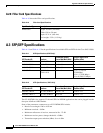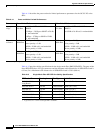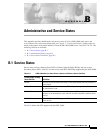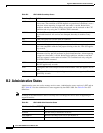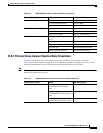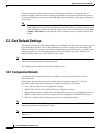
B-3
Cisco ONS 15600 Reference Manual, R7.2
Appendix B Administrative and Service States
B.3 Service State Transitions
B.3 Service State Transitions
This section describes the transition from one service state to the next for cards, ports, and
cross-connects. A service state transition is based on the action performed on the entity.
Note
When an entity is put in the OOS,MT administrative state, the ONS 15600 suppresses all standing alarms
on that entity. All alarms and events appear on the Conditions tab. You can change this behavior for the
LPBKFACILITY and LPBKTERMINAL alarms. To display these alarms on the Alarms tab, set the
NODE.general.ReportLoopbackConditionsOnOOS-MTPorts to TRUE on the NE Defaults tab.
B.3.1 Card Service State Transitions
Table B-4 lists card service state transitions.
Table B-4 ONS 15600 Card Service State Transitions
Current Service State Action Next Service State
IS-NR Change the administrative state
to OOS,MT.
OOS-MA,MT
Delete the card. OOS-AUMA,UAS
Pull the card. OOS-AU,UEQ
Reset the card. OOS-AU,SWDL
Alarm/condition is raised. OOS-AU,FLT
OOS-AU,AINS and MEA Pull the card. OOS-AU,AINS & UEQ
Delete the card. OOS-AUMA,UAS if the card is
valid
OOS-AUMA,MEA & UAS if the
card is invalid
OOS-AU,AINS & SWDL Restart completed. IS-NR
Pull the card. OOS-AU,AINS & UEQ
OOS-AU,AINS & UEQ Insert a valid card. OOS-AU,AINS & SWDL
Insert an invalid card. OOS-AU,AINS & MEA
Delete the card. OOS-AUMA,UAS & UEQ
OOS-AU,FLT Pull the card. OOS-AU,UEQ
Delete the card. OOS-AUMA,UAS
Change the administrative state
to OOS,MT.
OOS-AUMA,FLT & MT
Reset the card. OOS-AU,SWDL
Alarm/condition is cleared. IS-NR






